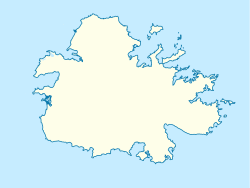User:CROIX/allsaintsrewrite
All Saints | |
|---|---|
Village | |
| All Saints Village | |
 All Saints in June 2023 | |
| Coordinates: 17°03′N 61°47′W / 17.050°N 61.783°W | |
| Country | Antigua and Barbuda |
| Island | Antigua |
| Civil parish | Saint Peter, Saint Paul, Saint John |
| Area | |
| • Total | 4.14 km2 (1.60 sq mi) |
| Elevation | 60 m (200 ft) |
| Population (2011) | |
| • Total | 3,438 |
| • Density | 2,148.75/km2 (5,565.2/sq mi) |
| Time zone | UTC-4 (AST) |
All Saints is the second largest town in Antigua and Barbuda, with a population of 3,412. It is located in central Antigua.
Within the vicinity of the town, in Pares, is Betty's Hope, the first large-scale sugarcane plantation in Antigua. Betty's Hope was built in 1674 by Sir Christopher Codrington, the namesake of Codrington, and was named for his daughter, Elizabeth Codrington. The only remaining structures are two stone sugar mills and the remains of the stillhouse, though its important role in Antigua's history has inspired its government to turn it into an open-air museum.[1] The area around All Saints is known for its traditional pottery. Potter's Village, a nearby settlement, is named after it.
Etymology[edit]
Five years following emancipation, in 1839, a chapel was constructed on Osborne's pasture. Because it was constructed close to the boundary of multiple parishes bearing saints' names—parishes were legally required to already exist on the island—this chapel was given the name "All Saints."[2]
History[edit]
The village of All Saints was established around 1840. At first, All Saints was called Free-Centre Village.[3] The village was also formerly known as Hymans Village before it was named All Saints. All Saints village was established shortly after the village chapel was constructed as sugar workers started to leave the estates and homes started to rise close to the chapel. The crossroads, the village's most central point, was where the church was built. St. John's Parish lies to the north-west, St. Peter's to the north-east, and St. Paul's to the south and south-east. The crossroads developed into the village's social, commercial, and cultural center. The school, police and fire stations, community medical clinic, post office, rum shops, retail and hardware stores, daycare, Village Community Council building, multiple churches, gas station, bakery, food stands, etc. are just a few of the many businesses, artesian trades, and vital services that have called it home for decades.[2]
There was a village council in All Saints beginning in the 1940s. The plan to establish a village council was approved by the Legislative Council on May 15, 1946, after it was published in the Gazette on April 11, 1946. This village council is currently inactive. The official boundaries of All Saints were established by the village council rules, which also granted the village a constitution. There were eight members of the village council: six were chosen by the village's residents, and two were appointed by the governor general. A bylaw could be made by the village council with cabinet approval.[4]
The village received piped water and electricity in the early 1960s. Regular live music events took place in the Community Council building. Due to the village's strategic location on the island, expanding services and activities, and increased population, All Saints saw a rise in both its significance and size.[2]
Geography[edit]
Demographics[edit]
Economy[edit]
Housing[edit]
Education[edit]
Health[edit]
Government and politics[edit]
See also[edit]
References[edit]
- ^ "Antigua and Barbuda / Exploring Antigua and Barbuda". Archived from the original on 2012-04-05. Retrieved 2007-10-27.
- ^ a b c "Antigua and Barbuda: All Saints Urban Profile | UN-Habitat" (PDF). unhabitat.org. Retrieved 2023-11-05.
- ^ "ANTIGUA & BARBUDA'S CULTURAL HERITAGE". antiguahistory.net. Retrieved 2023-11-05.
- ^ "The Village Council Rules" (PDF). Archived from the original (PDF) on 5 November 2023.

